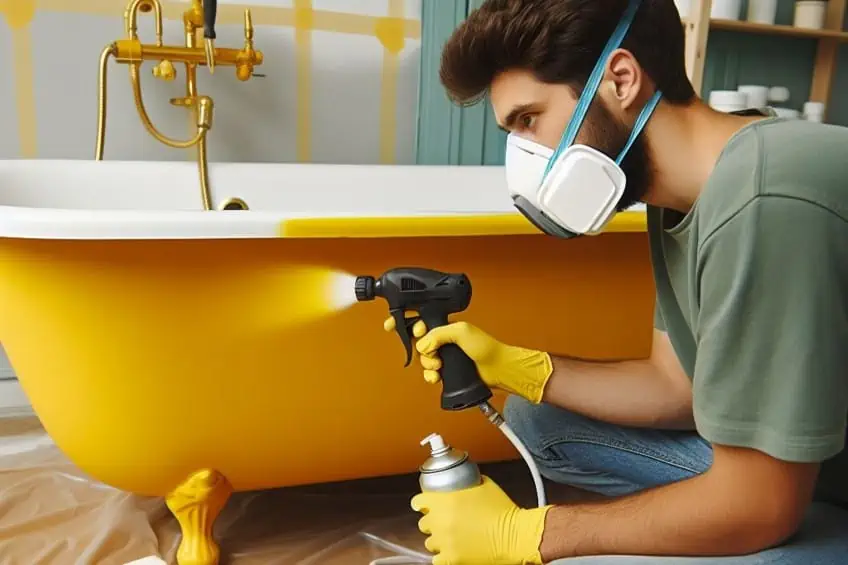How to Paint a Bathtub – Going from Drab to Fab
This post may contain affiliate links. We may earn a small commission from purchases made through them, at no additional cost to you.
Welcome to the colorful world of bathtub transformations! If you’re tired of staring at that dull, worn-out bathtub, fear not – with a stroke of paint and a splash of creativity, you can turn your bathing haven into a masterpiece. In this guide, we’ll dive into the bubbly process of painting your bathtub, unlocking the secrets to a smooth finish and a revitalized bathroom vibe. Get ready to dip your brushes and let your imagination take the plunge!
Table of Contents
Key Takeaways
- Painting a bathtub is a detailed process that can refresh the look of a bathroom.
- Proper preparation of the bathtub surface is key to ensuring a successful paint job.
- The application and curing of bathtub-specific paint should be done according to manufacturer instructions.
Preparing the Bathtub
Revitalizing an old bathtub can transform the entire appearance of a bathroom. Instead of costly replacements, painting a bathtub is a viable and cost-effective option that homeowners can undertake to give their tubs a fresh, new look.
This DIY project involves a step-by-step process, starting from meticulous surface preparation to the actual application of a special kind of paint, typically an epoxy resin-based product designed to adhere to ceramic or porcelain surfaces.
The result, when done correctly, is a smooth and durable finish that can extend the life of the bathtub for many years. However, as with any home improvement project, the quality of the outcome is contingent on the attention to detail during the process. Preparing the bathtub efficiently is crucial; all old caulk must be stripped off and any cracks or scratches need to be repaired. Following the preparation phase, it’s important to ensure the proper paint application.

Techniques vary, some prefer to use a paint gun for an even coat, while others may opt for traditional brushes or rollers. In all cases, following the manufacturer’s instructions for mixing, applying, and curing the paint is essential for a long-lasting finish.
Once painted, appropriate curing time and re-caulking are the final steps to weatherproof the bathtub and ensure a professional appearance.
Before a bathtub can be painted, it requires thorough preparation to ensure the paint adheres well and the finished job looks professional. This includes gathering the proper tools, performing a detailed clean and repair, and preparing the surface through sanding and priming.
Tools
One will need specific tools to effectively prepare a bathtub for painting. These include:
- Caulk removal tool for stripping away old caulk around the bathtub.
- Sandpaper, specifically 400-grit wet/dry sandpaper, for sanding the bathtub’s surface.
- Rust-oleum tub cleaner or another similar abrasive cleaner to remove rust and discoloration.
- Acetone or isopropyl alcohol to wipe down the tub.
- Epoxy putty or filler for mending scratches and dings.
- Cleaning supplies like Comet or a DIY tub cleaner.
- Protective gloves and safety goggles.
Cleaning and Repairing
Proper cleaning is critical. One should remove all traces of soap scum, mildew, and debris using an abrasive tub cleaner. Next, the bathtub drain and fixtures should be covered or removed to prevent damage from the cleaning agents and paint. After cleaning, the tub must be dried completely.
To begin repairing your bathtub, identify scratches, dings, or discolorations.

Then, apply epoxy putty or a suitable filler to these imperfections, making sure to cover them thoroughly. Follow the manufacturer’s instructions for curing time, allowing the putty or filler to set completely before proceeding. Patience during this step ensures a durable and effective repair.
Sanding and Priming
Sanding the bathtub creates a surface that helps the paint adhere better. One should evenly sand the entire tub with 400 grit wet/dry sandpaper, paying extra attention to any repaired spots. After sanding, the tub must be cleaned again to remove any dust and particles.
To kickstart the priming process for your bathtub, begin by applying a layer of primer specifically designed for bathtubs, usually an epoxy-based product.

Make sure to coat the entire surface of the tub evenly, ensuring no spots are missed. Then, be sure to follow the drying instructions provided on the product label, allowing sufficient time for the primer to dry thoroughly. This step sets the foundation for a smooth and long-lasting paint finish on your bathtub.
Applying the Paint
Before applying paint to a bathtub, one must select the appropriate type of paint and understand the proper painting process to ensure lasting results and a high-quality finish.
Choosing the Right Paint
The choice of paint is critical when refinishing a bathtub. Epoxy-based paint or a two-part epoxy paint is often recommended due to its durability and suitability for the bathroom’s high moisture environment. A refinishing kit, such as the Rustoleum tub & tile refinishing kit, provides all the necessary materials and instructions for a successful application.
These kits typically include the paint and a hardener that, when mixed, create a strong, waterproof surface.
Painting Process
The painting process involves several key steps performed with care. One should begin with a clean and prepped bathtub surface, void of any caulk and residue. Using a high-quality paintbrush or foam paint roller is essential for achieving a smooth, even application of the initial coat.
To start painting your bathtub, apply a thin, even layer of epoxy paint using a brush for edges and corners, and a foam roller for larger areas, ensuring no drips or uneven lines.

Once the first coat dries, follow with additional coats as needed to achieve full coverage and desired thickness, ensuring a professional finish for your bathtub renovation. Allow each coat of paint to dry as recommended by the manufacturer, typically for at least 24 hours, to ensure proper adhesion and finish. It’s important that during this time, the bathroom is well-ventilated.
Finishing Touches
After applying paint to the bathtub, the final stage is crucial for both the appearance and longevity of the refinishing job. The key components involve re-caulking for a waterproof seal and allowing adequate time for curing and drying.
Re-Caulking the Tub
Re-caulking the tub is essential for sealing the edges and preventing water from seeping beneath the surface. One should:
- Remove old caulk: Carefully cut away the old caulk using a putty knife, making sure not to scratch the newly painted surface.
- Clean the area: Wipe the seams clean of any residue to ensure a smooth surface for the new caulk.
- Apply new caulk: Using a caulk gun, apply a bead of fresh caulk made specifically for bathrooms. Smooth the caulk with a damp finger or caulking tool.
Curing and Drying Time
Proper drying and curing are essential for the paint’s durability. During the drying phase, utilize fans and ensure adequate ventilation to expedite the process, while refraining from exposing the tub to water. Once dried, the curing of acrylic urethane enamel can take up to 48 hours.
It’s imperative to exercise patience and wait until the paint is fully cured before using the bathtub to prevent any potential damage to the surface.
Safety and Maintenance
When undertaking a bathtub refinishing project, safety considerations are paramount. It’s vital to ventilate the area effectively; open windows and use fans to circulate the air to mitigate fumes from paint and refinishing products. Protective gear, such as rubber or disposable gloves and safety glasses, should be worn to prevent skin and eye irritation.
Before starting, the area around the bathtub should be covered with plastic sheeting to protect the flooring and fixtures from drips or spills. When preparing the bathtub surface, one might need to use a liquid drain opener for thorough cleaning; it’s essential to follow the product’s safety instructions closely.
The process of scraping old caulk and paint may require a razor blade. One should proceed with caution to avoid injury and also prevent damage to the fiberglass, porcelain, or ceramic materials. After scraping, use rags to clean the surface of any debris and dust. In the maintenance phase post-refinishing, use non-abrasive cleaners to maintain the integrity of the bathtub’s new coating. Avoid any harsh chemicals that can damage the finish. Regular cleaning will also prevent buildup and extend the life of the bathtub’s surface.

For those painting adjacent items like a sink, the same safety measures apply. One should use painter’s tape to shield any areas not being painted, ensuring clean lines and professional-looking results. If any DIY project, including bathtub refinishing or reglazing, feels overwhelming, consider hiring professionals, especially for complex tub repair products that might require specialized knowledge for proper application. This approach ensures safety and maintains the quality of the bathtub’s surface for years to come.
As you put the finishing touches on your newly painted bathtub, take a moment to bask in the glory of your DIY triumph! With a little elbow grease and a lot of imagination, you’ve transformed your bathing space from drab to fab. Now, every soak will feel like a dip in your own personal oasis. Remember, the key to a successful bathtub makeover is patience and a willingness to dive into the creative process. So go ahead, grab your paintbrushes, and let your bathroom dreams take flight – because when it comes to DIY magic, the only limit is your imagination!
Frequently Asked Questions
What Kind of Paint Is Best for Refinishing a Bathtub?
For bathtub refinishing, epoxy or urethane-based paints are most effective. These paints are specifically designed for durability and to withstand the moist conditions of a bathroom. When applying, one must ensure that the area is well-ventilated and follow the manufacturer’s instructions for the best results.
Is It Advisable to Repaint a Porcelain Bathtub?
Repainting a porcelain bathtub can be a practical choice to update its appearance. The key is to prepare the surface properly by cleaning, sanding, and applying a primer designed for porcelain. One should use a high-quality appliance paint that’s compatible with porcelain and apply it using a spray gun for an even finish. It’s important to allow ample drying time before using the bathtub again.
Robert Thompson has worked as a self-employed carpenter for over 15 years. He lives with his family in Billings, Montana, where he also successfully operates his business as a woodworker. His main business is the complete interior construction of buildings. He is also passionate about creating high-quality wood furniture with epoxy and other items made from burl wood. Besides the woodwork, Robert is also a skilled DIY professional for all kinds of materials. He always has a solution ready for every craft and construction challenge. Originally, Robert studied civil engineering and has advanced degrees in carpentry and business management. Robert has been working for Craft Art since 2020 and enriches the blog with his immense knowledge and skills in the field of woodworking and home improvement. He writes the articles about DIY and Repair.
Learn more about Robert Thompson and about us.









